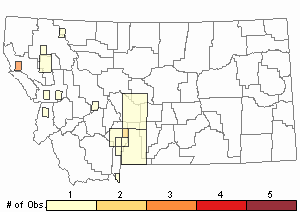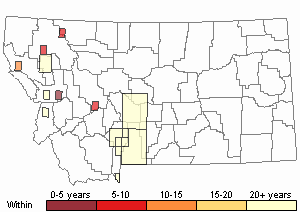View in other NatureServe Network Field Guides
NatureServe
Montana
Utah
Wyoming
Idaho
Wisconsin
British Columbia
South Carolina
Yukon
California
New York
Crackling Forest Grasshopper - Trimerotropis verruculata
General Description
The following is taken from Hebard (1928), Brooks (1958), Helfer (1971), Capinera and Sechrist (1982), Otte (1984), Vickery and Kevan (1985), Richman et al. (1993), and Scott (2010). In the literature, this species can be found under various taxonomic names: Trimerotropis suffuse, and T. verruculata (or verruculatus). In this field guide, we will be combining the features described by Otte (1984) and Vickery and Kevan (1985). This subspecies is morphologically and behaviorally nearly identical to that of T. verruculata, which is also now the subspecies T. v. verruculata (which has not been recorded in Montana). The body color of T. v. suffuse is dark brown or dark gray to almost black. The tegmina (forewings) are uniformly dark with darker spotting, without crossbands. The hindwing disk is yellow with a broad black band, and a smoky-black, paler apex. The hindwing veins are enlarged in males for loud crepitation. The median carina (ridge) of the pronotum (thorax) is elevated, moderately cut by two sulci (grooves). The outer face of the hind femur is dark brown with diffuse banding (sometimes almost absent). The hind femur inner face is bluish-black forming one or two complete pale bands. The hind tibia variable, being yellow-brown, bluish, or greenish blue with a prebasal pale band below the base (more obvious on the inner side of the tibia).
Communicative behavior/Crepitation*
The male Crackling Forest Grasshopper flies upward from a bare patch of ground, performing an up-and-down, hovering in a zigzag flight pattern, and producing pairs of loud, closely spaced snapping sounds, lasting from a few seconds up to a minute or more! They then drop to the ground, sometimes landing at another bare spot several feet away. They often repeat such flights within 10-15 seconds. Females have also been observed performing similar crepitation flights but with less intense in sound. Femur tipping, shaking, and striking the ground with its femora in male-to-male aggression encounters, and sometimes with the forewings at the same time. Females repel courting males by raising their femora vertically (Otte 1970, 1984, and Vickery and Kevan 1985).
*Crepitation is the sound produced by grasshoppers making a clicking or snapping noise with their wings when in flight, during courtship, territorial encounters or being disturbed.
Phenology
This species overwinters in the egg stage. Nymphs appear in June. Adults occur from late June or early July to early September (Capinera and Sechrist 1982, Otte 1984, Vickery and Kevan 1985, and Scott 2010).
Diagnostic Characteristics
The following comes from Hebard (1928), Brooks (1958), Helfer (1971), Capinera and Sechrist (1982), Otte (1984), Vickery and Kevan (1985), Richman et al. (1993), and Scott (2010). Body length to the tip of the forewings for males 28-35 mm, for females 32-38 mm.
Can be confused with
Thomas’ Fontana Grasshopper (
Trimerotropis fontana).
Species Range
Montana Range
Range Descriptions

 Native
Native
Range Comments
This subspecies occurs from the mountains of British Columbia and Alberta, southward to Arizona, from the west in Washington, Oregon, and California, eastward to the western third of Montana, western Wyoming, and Colorado. The two subspecies contact each other in the mountains along the southern border of British Columbia and Alberta. In Montana, it has been reported for 8 counties (Otte 1984, and Vickery and Kevan 1985).
Observations in Montana Natural Heritage Program Database
Number of Observations: 34
(Click on the following maps and charts to see full sized version)
Map Help and Descriptions
Relative Density

Recency



 (Observations spanning multiple months or years are excluded from time charts)
(Observations spanning multiple months or years are excluded from time charts)
Habitat
Mostly inhabits pine forest openings in mountainous areas, often on ridges, eroded slopes, and rocky courses of mountain streams (Otte 1984).
Food Habits
The Crackling Forest Grasshopper is considered a mixed feeder of grasses and forbs, preferring lupine and yarrow (Capinera and Sechrist 1982).
Reproductive Characteristics
A courting male makes 1-4 stridulations* with one femur when approaching a female on the ground. No femur tipping or shaking is performed by either gender. The nymphs pass through 5 instars before reaching the adult stage. No further observations have been reported and described in the literature relative to this species’ reproduction and life cycle (Capinera and Sechrist 1982, Otte 1970, 1984, and Vickery and Kevan 1985).
*Stridulation is rubbing one body part against another, usually the hind femur against the forewing in the case of the Band-winged Grasshoppers. This is often used for attracting a female during courtship (Otte 1970).
Stewardship Responsibility
References
- Literature Cited AboveLegend:
 View Online Publication
View Online Publication Brooks, A.R. 1958. Acridoidea of Southern Alberta, Saskatchewan, and Manitoba (Orthoptera). The Canadian Entomologist (Supplement 9) 90:5-92.
Brooks, A.R. 1958. Acridoidea of Southern Alberta, Saskatchewan, and Manitoba (Orthoptera). The Canadian Entomologist (Supplement 9) 90:5-92. Capinera, J.L. and T.S. Sechrist. 1982. Grasshoppers of Colorado: Identification, Biology, and Management. Fort Collins, CO: Colorado State University Experiment Station, Bulletin 584S. 161 p.
Capinera, J.L. and T.S. Sechrist. 1982. Grasshoppers of Colorado: Identification, Biology, and Management. Fort Collins, CO: Colorado State University Experiment Station, Bulletin 584S. 161 p. Hebard, M. 1928. The Orthoptera of Montana. Proceedings of the Academy of Natural Sciences of Philadelphia, Vol. 80:211-306.
Hebard, M. 1928. The Orthoptera of Montana. Proceedings of the Academy of Natural Sciences of Philadelphia, Vol. 80:211-306. Helfer, J.R. 1971. How to Know the Grasshoppers, Crickets, Cockroaches, and Their Allies. Revised edition (out of print), Mineola, NY: Dover Publications.
Helfer, J.R. 1971. How to Know the Grasshoppers, Crickets, Cockroaches, and Their Allies. Revised edition (out of print), Mineola, NY: Dover Publications. Otte, Daniel. 1970. A comparative study of communicative behavior in grasshoppers. Miscellaneous Publications, Museum of Zoology, No. 141. Ann Arbor, MI: University of Michigan.
Otte, Daniel. 1970. A comparative study of communicative behavior in grasshoppers. Miscellaneous Publications, Museum of Zoology, No. 141. Ann Arbor, MI: University of Michigan. Otte, Daniel. 1984. The North American Grasshoppers Volume II. Acrididae (Oedipodinae). Harvard University Press. 366 pp.
Otte, Daniel. 1984. The North American Grasshoppers Volume II. Acrididae (Oedipodinae). Harvard University Press. 366 pp. Richman, D.B., D.C. Lightfoot, C.A. Sutherland, and D.J. Ferguson. 1993. A manual of the grasshoppers of New Mexico. Las Cruces, NM: Cooperative Extension Service, Handbook No. 7.
Richman, D.B., D.C. Lightfoot, C.A. Sutherland, and D.J. Ferguson. 1993. A manual of the grasshoppers of New Mexico. Las Cruces, NM: Cooperative Extension Service, Handbook No. 7. Scott, R.D. 2010. Montana Grasshoppers, Katydids, and Crickets A Pictorial Field Guide to the Orthoptera. MagpieMTGraphics, Billings, MT.
Scott, R.D. 2010. Montana Grasshoppers, Katydids, and Crickets A Pictorial Field Guide to the Orthoptera. MagpieMTGraphics, Billings, MT. Vickery, V. R. and D. K. M. Kevan. 1985. The grasshopper, crickets, and related insects of Canada and adjacent regions. Biosystematics Research Institute, Ottawa, Ontario. Publication Number 1777. 918 pp.
Vickery, V. R. and D. K. M. Kevan. 1985. The grasshopper, crickets, and related insects of Canada and adjacent regions. Biosystematics Research Institute, Ottawa, Ontario. Publication Number 1777. 918 pp.
- Additional ReferencesLegend:
 View Online Publication
View Online Publication
Do you know of a citation we're missing? Bland, R.G. 2003. The Orthoptera of Michigan—Biology, Keys, and Descriptions of Grasshoppers, Katydids, and Crickets. East Lansing, MI: Michigan State University Extension, Bulletin E-2815. 221 p.
Bland, R.G. 2003. The Orthoptera of Michigan—Biology, Keys, and Descriptions of Grasshoppers, Katydids, and Crickets. East Lansing, MI: Michigan State University Extension, Bulletin E-2815. 221 p. Capinera, J.L., R.D. Scott, and T.J. Walker. 2004. Field Guide to Grasshoppers, Katydids, and Crickets of the United States. Ithaca, NY. Cornell University Press.
Capinera, J.L., R.D. Scott, and T.J. Walker. 2004. Field Guide to Grasshoppers, Katydids, and Crickets of the United States. Ithaca, NY. Cornell University Press. Kirk, K. and C.R. Bomar. 2005. Guide to the grasshoppers of Wisconsin. Madison, WI: Wisconsin Department of Natural Resources, Bureau of Integrated Science Services PUB-SS-1008. 154 p.
Kirk, K. and C.R. Bomar. 2005. Guide to the grasshoppers of Wisconsin. Madison, WI: Wisconsin Department of Natural Resources, Bureau of Integrated Science Services PUB-SS-1008. 154 p. Wachter, D.H. 1995. The ecology of selected grasshopper species along an elevational gradient. M.Sc. Thesis. Bozeman, Montana: Montana State University. 59 p.
Wachter, D.H. 1995. The ecology of selected grasshopper species along an elevational gradient. M.Sc. Thesis. Bozeman, Montana: Montana State University. 59 p.
- Web Search Engines for Articles on "Crackling Forest Grasshopper"
- Additional Sources of Information Related to "Insects"





